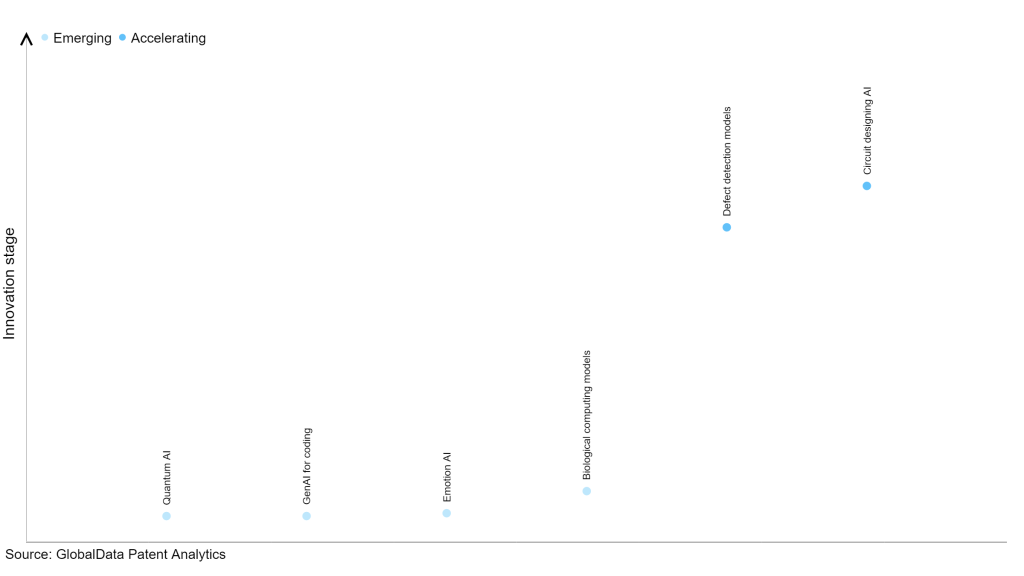The technology industry continues to be a hotbed of patent innovation. Activity is driven by the increasing demand for artificial intelligence (AI)-powered solutions, coupled with advancements in hardware that enable more powerful and energy-efficient inference engines, and growing importance of technologies such as hardware accelerators, optimized software frameworks, and model compression techniques. In the last three years alone, there have been over 1.5 million patents filed and granted in the technology industry, according to GlobalData’s report on Artificial intelligence in technology: deep learning inference engines. Buy the report here.
However, not all innovations are equal and nor do they follow a constant upward trend. Instead, their evolution takes the form of an S-shaped curve that reflects their typical lifecycle from early emergence to accelerating adoption, before finally stabilizing and reaching maturity.
Identifying where a particular innovation is on this journey, especially those that are in the emerging and accelerating stages, is essential for understanding their current level of adoption and the likely future trajectory and impact they will have.
185+ innovations will shape the technology industry
According to GlobalData’s Technology Foresights, which plots the S-curve for the technology industry using innovation intensity models built on over 1.6 million patents, there are 185+ innovation areas that will shape the future of the industry.
Within the emerging innovation stage, quantum AI, GenAI for coding and emotion AI are disruptive technologies that are in the early stages of application and should be tracked closely. Biological computing models, defect detection models and circuit designing AI are some of the accelerating innovation areas, where adoption has been steadily increasing.
Innovation S-curve for artificial intelligence in the technology industry

Deep learning inference engines is a key innovation area in artificial intelligence
Deep learning inference engines are specialized systems or algorithms crafted to execute inference operations with deep learning models. Inference, in this context, pertains to the act of making forecasts or determinations by applying a trained deep learning model to input data. These engines facilitate swift and effective deployment of deep learning models for functions such as image identification, natural language processing, and pattern recognition.
GlobalData’s analysis also uncovers the companies at the forefront of each innovation area and assesses the potential reach and impact of their patenting activity across different applications and geographies. According to GlobalData, there are 1490 companies, spanning technology vendors, established technology companies, and up-and-coming start-ups engaged in the development and application of deep learning inference engines.
Key players in deep learning inference engines – a disruptive innovation in the technology industry
‘Application diversity’ measures the number of applications identified for each patent. It broadly splits companies into either ‘niche’ or ‘diversified’ innovators.
‘Geographic reach’ refers to the number of countries each patent is registered in. It reflects the breadth of geographic application intended, ranging from ‘global’ to ‘local’.
Patent volumes related to deep learning inference engines
Source: GlobalData Patent Analytics
Among the companies innovating in AI in deep learning inference engines, International Business Machines (IBM) is one of the leading patents filers. The company’s patents are aimed at overseeing and engaging with a conversational agent within an internet of things (IoT) framework by a processor. From a sensor list comprising one or more IoT sensors, the knowledge graph is formed, and subsequently, one or more graph patterns are derived. The sensor list and graph patterns are used to learn one or more conversation patterns and dialogs. The conversational agent is then automatically equipped with the acquired graph patterns, conversation patterns, conversation dialogs, as well as sensor data and analytics from the IoT sensors. This is done in response to one or more queries, enabling the agent to engage in a conversation with a user. The other prominent patent filers in the space include Microsoft and Samsung Group.
In terms of application diversity, Microsoft leads the pack, while Fanuc and Stryker stood in the second and third positions, respectively. By means of geographical reach, Stryker held the top position, followed by Digital Global Systems and Bayer.
AI in deep learning inference engines have the ability to process complex neural networks efficiently, making them instrumental in real-time applications. These engines excel at rapidly making accurate predictions or decisions based on input data, which is crucial in fields such as autonomous vehicles, healthcare, and other industries where timely responses are vital.
To further understand the key themes and technologies disrupting the technology industry, access GlobalData’s latest thematic research report on Artificial Intelligence (AI).
Data Insights
From

The gold standard of business intelligence.
Blending expert knowledge with cutting-edge technology, GlobalData’s unrivalled proprietary data will enable you to decode what’s happening in your market. You can make better informed decisions and gain a future-proof advantage over your competitors.







